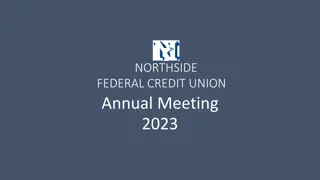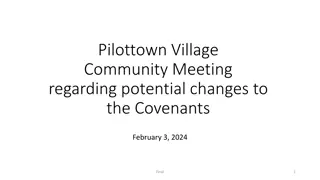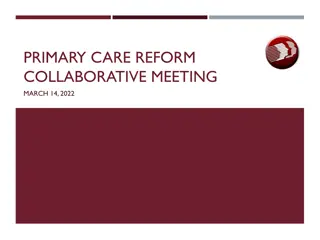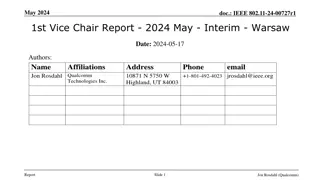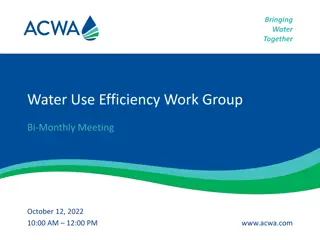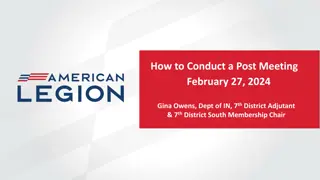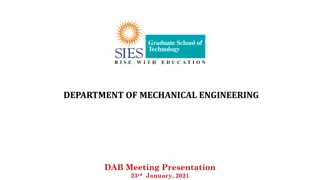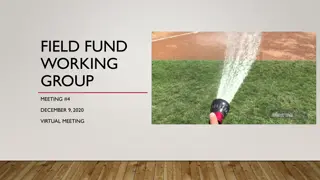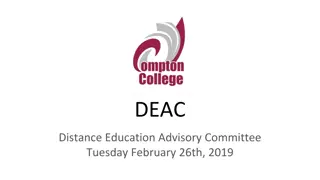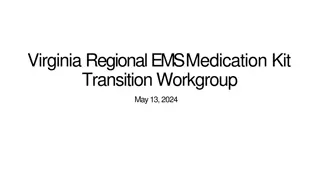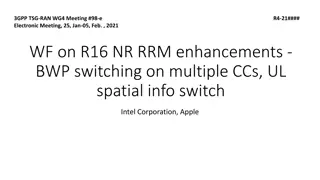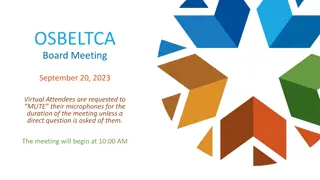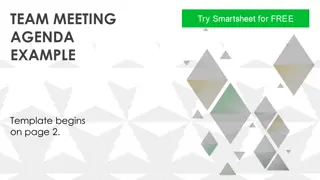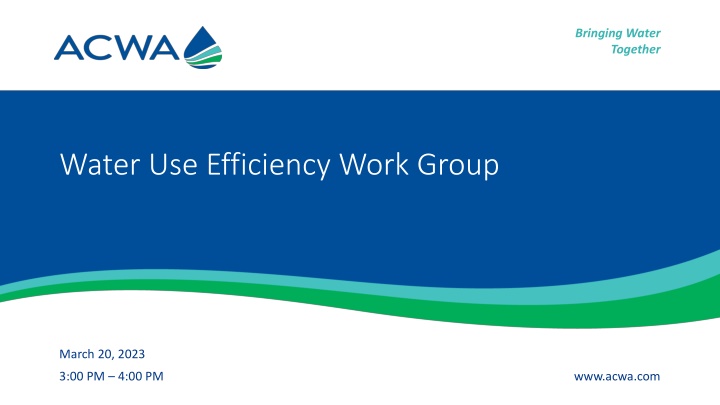
Water Efficiency Work Group Meeting Agenda and Updates March 20, 2023
Stay updated on Water Use Efficiency regulatory updates, SWRCB recommendations, and ACWA concerns at the upcoming work group meeting on March 20, 2023. Learn about proposed objectives, standards, and strategies to improve water use efficiency and reduce demand for a sustainable water future.
Download Presentation

Please find below an Image/Link to download the presentation.
The content on the website is provided AS IS for your information and personal use only. It may not be sold, licensed, or shared on other websites without obtaining consent from the author. If you encounter any issues during the download, it is possible that the publisher has removed the file from their server.
You are allowed to download the files provided on this website for personal or commercial use, subject to the condition that they are used lawfully. All files are the property of their respective owners.
The content on the website is provided AS IS for your information and personal use only. It may not be sold, licensed, or shared on other websites without obtaining consent from the author.
E N D
Presentation Transcript
Bringing Water Together Water Use Efficiency Work Group March 20, 2023 www.acwa.com 3:00 PM 4:00 PM
Meeting Agenda 1. WUE Regulatory Updates 2. SWRCB Proposed Recommendation 3. ACWA Concerns 4. Call for Your Engagement
WUE Regulatory Update 1. Oct. 2022 DWR 21 technical reports 2. March 2023 SWRCB preliminary regulatory framework o March 22 - Public Workshop (Speaker Card- # 7) o March 30 Informal Written Comments 3. SRIA (to be posted here) 4. Formal Rulemaking o Formal comment period (reg text, SRIA, overall approach)
SWRCB Proposed Recommendation DWR 8 variances + 2 SWRCB recommended Residential: *0.55 LEF by 2035 Residential: 42 gpcd by 2030 (Wat. Code 10609.4) Individual System Loss Standards or alternative compliance pathway Potable recycled water (Wat. Code 10609.2) CII landscape w/ DIMS: 0.45 LEF by 2035 + CII Performance Measures
SWRCB Proposed Recommendation State Water Board Water Use Objective Exploration Tool: - - - Residential Indoor: 42 Residential Outdoor: 0.63/ 0.55 Landscape area: 0 https://www.waterboards.ca.gov/water_issues/p rograms/conservation_portal/regs/objective- exploration.html
SWRCB Proposed Recommendation SWRCB Perspective: Water Supply Strategy reduce demand by 500,000 AF by 2030 Water use efficiency observed as cost-effective Proposed Objectives seem reasonable
SWRCB Proposed Recommendation Proposed Outdoor Standards: SWRCB Proposal DWR Recommendation Residential (Existing) Now - 2030: 0.8 LEF 2030 2035: 0.63 LEF 2035 +: 0.55 LEF Now - 2030: 0.8 ETF 2030 +: 0.63 ETF New Construction (post-2030) 0.55 LEF (Residential) 0.45 LEF (Non-Residential) 0.55 ETF (Residential) 0.45 ETF (Non-Residential) CII DIM Now - 2030: 0.8 LEF 2030 2035: 0.63 LEF 2035 +: 0.45 ETF Now - 2030: 0.8 ETF 2030 +: 0.63 ETF Effective Precipitation Up to 25% of calculated EP Up to 25% of calculated EP
SWRCB Proposed Recommendation Outdoor Standards: SWRCB Proposal DWR Recommendation Irrigable, Not Irrigated Up to 20%, if demonstrated those INI areas have come under irrigation. 20% of INI (automatic INI Buffer) Special Landscape Areas -SLAs 100% LEF For residential areas and CII landscapes with DIMs, areas planted with non-functional turf would not be considered SLAs. This includes sites irrigated with recycled water. They would instead use whatever applicable standard is for the time period (80%, 63%, 55% or 45%) SLAs 100% LEF
SWRCB Proposed Recommendation Variances SWRCB Proposed Recommendations A provision for urban tree health A provision for pools, spas & other water features (2030) Process for including additional Irrigable Irrigated Area, Special Landscape Area & Variances Annually request approval to include additional II area beyond that calculated by DWR, SLAs, and variances URWS to provide information quantifying request and description of efforts to prioritize water for existing trees DWR Recommended Variances: Significant use of evaporative coolers Significant populations of horses and other livestock Significant fluctuations in seasonal populations
SWRCB Proposed Regulatory Framework Significant LAs irrigated with recycled water having high levels of total dissolved solids Significant use of water for soil compaction and dust control Significant use of water to supplement ponds and lakes to sustain wildlife Significant use of water to irrigate vegetation for fire protection Significant use of water for commercial or noncommercial agricultural areas Examples: Evaporative Coolers o URWS to calculate based on information collected from customers o Conditions & Proof (e.g., customer picture of EC and unit specification, minimum air temp) o DWR recommends that URWS establish a report for or survey to obtain information, must obtain EC Operating Hours in each residential property in its service area, hourly weather data
SWRCB Proposed Regulatory Framework CII Performance Measures Install DIMs or in-lieu technologies for landscapes of CII customers o Do not have a DIM o Estimates using 500 million gallon of water or more annually Energy Star Classifications 1. 2. 3. Banking/ Financial services Education Entertainment/ public assembly Food sales and service Healthcare Lodging/ residential Manufacturing/ industrial Mixed use Office 10. Parking 11. Public service 12. Religious Worship 13. Retail 14. Technology/ science 15. Services 16. Utility 17. Warehouse/ storage 18. Other 4. 5. 6. 7. 8. 9. Classify customers according to Energy Star Portfolio Manager tool Suppliers to offer BMPs to their customers a. For customers that own on manage a building a disclosable building under CEC Benchmarking regulation, supplies required to provide annual water use data in format compatible with ENERGYSTARS Portfolio Manager tool.
SWRCB Proposed Regulatory Framework Energy Star Classifications CII Performance Measures Suppliers to offer BMPs to their customers (cont.) 1. 2. 3. Banking/ Financial services Education Entertainment/ public assembly Food sales and service Healthcare Lodging/ residential Manufacturing/ industrial Mixed use Office 10. Parking 11. Public service 12. Religious Worship 13. Retail 14. Technology/ science 15. Services 16. Utility 17. Warehouse/ storage 18. Other b. Customers in top 20% of water use relative to customers within specific CII classification, design and implement a conservation program that includes at least 1 BMP from 5 categories 4. 5. 6. 7. 8. 9. c. Customer in top 2.5% of water use of all CII customers. The supplier should design and implement at least 2 BMPs from each BMP category
ACWA Concerns Outdoor Standard 1. Methodology 2. Feasibility 3. Cost 4. Timeline 5. Compliance 6. Caps/ Alternative Compliance 7. Effective Precipitation Horticultural Approach 0.8 IE Statewide ETF Trimmed Data Theoretical Average Application of MWELO INI (inconsistent with water code) Effective Precipitation Special Landscape Areas & non-functional turf Policy Considerations ORWUS Methodology
ACWA Concerns CII Performance Measures 1. Implementation timelines and compliance should provide flexibility, rather than being prescriptive. 2. PM should support suppliers efforts or strategies to advance WUE in the CII sector. 3. URWS compliance should be determined by local and regional availability of PMs, rather than customer level adoption. 4. Simplify reporting burdens on URWS. 5. The State should provide technical assistance and data as soon as possible. 6. Recognize CII LAM mapping will improve data for the CII DIM standard. Variances 1. Data burden on water suppliers 2. State Water Board capacity and resources required 3. Provide technical Assistance Provided
Call for Your Engagement March 22 - Board Workshop Speaker Card Help highlight feasibility, cost and timeline concerns o Conservation budgets over time o Savings per use o Amount of customers reached o Amount of landscaped area reached o Cost to implement level required o Local challenges March 30 Informal Written Comments o orpp-waterconservation@waterboards.ca.gov o Please forward your comments to Chelseah@acwa.com

